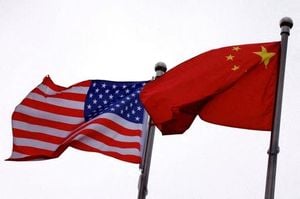The global commodity markets are in the midst of a dramatic transformation as 2025 draws to a close, with a perfect storm of geopolitical tensions, energy transition demands, and a new focus on supply chain security reshaping the landscape for strategic materials. From uranium and rare earth metals to the sudden spotlight on antimony, these critical resources are now at the heart of international competition, industrial strategy, and investment flows.
According to Market Minute, the volatility rocking commodity markets is unlike anything seen in recent decades. Strategic materials—especially uranium and rare earths—are now the lifeblood of national security and economic development, with their supply chains under unprecedented scrutiny. The result? Input costs are rising for sectors like automotive, electronics, and defense, and inflationary pressures are rippling through global economies. Nations are scrambling to secure their own supply, fragmenting traditional alliances and injecting a significant premium into commodity prices as countries compete for access.
The uranium market exemplifies these trends. After years of underinvestment following the 2011 Fukushima disaster, the world faces a structural uranium deficit. Demand for nuclear fuel is surging, driven by decarbonization commitments, energy security concerns, and the power needs of emerging technologies such as AI data centers. In 2024, the warning bells rang loud: countries like Japan placed uranium orders for the first time in over a decade, signaling the depletion of stockpiled reserves. The U.S. ban on Russian uranium imports further fractured the market, redirecting capital toward domestic and allied producers and exposing vulnerabilities in global supply chains.
Rare earth elements (REEs) are under similar strain. These minerals are essential for everything from electric vehicles and wind turbines to advanced defense systems. China, controlling roughly 85% of global rare earth processing capacity, has weaponized this dominance. In April 2025, Beijing imposed export controls, and by October, these restrictions specifically targeted rare earths used by the U.S. defense sector. The move underscored a new era where technological sovereignty and national security are deeply intertwined with access to critical minerals.
In response, the U.S. and its allies are moving fast to diversify. On October 26, 2025, the U.S. and Thailand signed a Memorandum of Understanding to cooperate on the full spectrum of rare earth supply chains—from exploration and extraction to refining and recycling. Australia has emerged as a cornerstone of U.S. rare earth sourcing, with projects like the Goschen Rare Earths and Mineral Sands Project and expansions by Australian Strategic Materials (ASX: ASM) in Korea and planned facilities in the U.S. These efforts, while promising, face the reality that new production capacity takes years to develop, leaving markets exposed to short-term shocks and speculative swings.
The corporate world is feeling the effects acutely. Companies with established mining operations in stable jurisdictions—think Cameco Corporation and Kazatomprom in uranium, Lynas Rare Earths Ltd. (ASX: LYC) and MP Materials Corp. (NYSE: MP) in rare earths—are poised to benefit from tightening supply and rising prices. Their infrastructure and long-term contracts are now prized assets. Conversely, manufacturers heavily reliant on single-source suppliers, particularly those dependent on Chinese-processed rare earths, face mounting risks. Electric vehicle makers, defense contractors, and advanced electronics firms could see their production lines disrupted and costs soar if export restrictions tighten further. Those without diversified supply chains or alternative material research may find themselves at a serious disadvantage.
Yet, the scramble for resources doesn’t end with uranium and rare earths. The spotlight has recently swung to antimony, a strategic metal crucial for defense, energy storage, and semiconductor manufacturing. As reported by NAI500, Perpetua Resources (NASDAQ: PPTA), the company behind the Stibnite gold-antimony project in Idaho, has become a market darling in 2025. Its stock has soared 158% year-to-date, closing at $24.84 on October 27 with a market capitalization of $2.7 billion—far outpacing the S&P 500’s 18% gain over the same period.
What’s driving this surge? Three major factors, according to NAI500. First, Perpetua achieved a decisive breakthrough in project permitting, officially commencing construction on the Stibnite Gold Project. This site is projected to produce 450,000 ounces of gold annually and meet over 35% of U.S. antimony demand. Second, the strategic value of antimony has skyrocketed after China halted exports in late 2024, creating a supply gap for this critical metal. The Stibnite project, as one of the largest antimony resources outside China, is now seen as vital to U.S. interests. Third, a wave of institutional confidence has poured in, with JPMorgan investing $75 million from its $1.5 trillion fund aimed at strengthening U.S. national security and Agnico Eagle, a major North American gold producer, contributing $180 million and direct operational expertise.
Doug Petno, Co-CEO of JPMorgan’s commercial and investment banking division, put it plainly: “This investment aims to support industries critical to national security and American resilience.” The message is clear—capital is flowing not just for returns, but to address critical mineral supply chain risks. Agnico Eagle’s participation, meanwhile, brings technical know-how and boots-on-the-ground support, reinforcing the sense that the Stibnite project is a national priority.
Of course, opportunity comes with risk. Brazilian investment firm JGP Global recently liquidated its entire 4.5 million-share position in Perpetua, a reminder that early-stage resource stocks are never without challenges. Perpetua has yet to generate revenue and reported a net loss of $22.1 million over the past year. The Stibnite project’s $1.3 billion total investment still requires finalizing its financing, with a crucial loan package from the U.S. Export-Import Bank pending. Off-take agreements with major refiners like Glencore and Trafigura are also in the works, with negotiations expected to conclude by year-end.
For investors, this is as much a bet on America’s ability to develop its own resources as it is on commodity prices. If Perpetua’s project begins production as planned in 2026, it could become the sole large-scale antimony producer in the U.S.—a position of strategic importance as geopolitical tensions and new energy demands continue to grow.
The broader implications are hard to overstate. The old model of purely cost-optimized, hyper-efficient global supply chains is giving way to an era where resilience, diversification, and strategic alliances rule. The weaponization of critical minerals—seen in China’s export controls and the West’s rush to “friend-shoring”—is accelerating a shift toward regionalized supply chains and new forms of industrial policy. The U.S. Critical Minerals Strategy and similar efforts in allied nations are now central to national security, featuring subsidies, strategic stockpiling, and streamlined permitting for critical projects.
Looking forward, volatility is likely to persist. Uranium’s structural deficit is expected to drive prices higher as utilities scramble for long-term contracts. China’s grip on rare earths will continue to pressure global supply chains, prompting ever more urgent diversification and research into alternative materials. New partnerships—like the U.S.-Thailand and Australia-U.S. critical minerals agreements signed in October 2025—will be closely watched as bellwethers for supply chain resilience. Meanwhile, environmental, social, and governance (ESG) factors are playing a bigger role in investment decisions, shaping the future of mining and processing worldwide.
As the race for strategic materials heats up, the winners will be those companies and nations that can adapt, innovate, and secure their own supply. For investors and policymakers alike, the coming months will be a test of resilience, foresight, and the ability to navigate a resource-constrained world where the stakes have never been higher.




